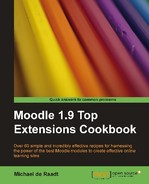|
Name |
Question Creation Module |
|
Module type |
Activity |
|
Author |
Jamie Pratt |
|
Released |
2008 |
|
Maintained |
Actively |
|
Languages |
English, Spanish |
|
Compliance |
Good |
|
Documentation |
Limited online documentation, help files |
|
Errors |
Some errors displayed when error reporting is turned on |
The Question Creation Module allows students to contribute Quiz questions and be rewarded with marks. This is a great pedagogical activity and the questions produced by students can be used in creative ways.
Unzip and copy the module directory into the /moodle/mod/ directory then visit the Notifications page.
After adding the Question Creation Module you can create an instance of this activity from the Add an activity... menu.
The configuration page for this module is somewhat overcomplicated, however, once you have used it, the settings become apparent.

Like most modules, there is a Name. There is also a description that appears as an Introduction to students in their view of the activity. A time period for the activity can be specified with an opening and closing date.
In the Grading section, there are a number of options, some of which are obvious and some that require explanation. A Question Creation activity can contribute to a course assessment and as such there is a Grade value. This grade value is constituted from a mix of:
- Automatic grading (based on number of questions created by a student, that is, a participation mark)
- Manual grading (based on a judgment of quality by the teacher
A 50%/50% mix means that the student gains half the available marks by simply creating the required number of questions and the other half based on the judgment of the teacher. A different ratio can be chose to shift this balance depending on the teacher's preference. For a fully automated assessment, a ratio of 100%/0% can be used. For a grade that is wholly based on the teacher's judgment a ratio of 0%/100% can be used.
The number of questions that need to be created can be specified. The grade value is then distributed across this number of questions.
The types of Quiz questions can be restricted to specific types or students can be allowed to create questions of any type. The teacher can direct that the student create a minimum number of questions of specified question types. For example, the teacher could direct that two of the questions that a student creates should be Multiple Choice. Such enforcement is achieved in the sections labeled (rather incomprehensibly) as Will Grade Minimum Number of Questions of Type (optional).
At the bottom of the configuration page, there is a setting that controls what level of editing students have over their own questions.

It is not clear at first what each level of access means, nor why access needs to be restricted. Students can be controlled in their freedom to create, preview, edit, and delete questions. The module author suggests that there may be complications if a student edits a question after it has been graded, although he also suggests that students could improve questions based on feedback and such questions could then be re-graded (and the module facilitates this). For the most intuitive setup for students, the highest level of access is probably best. The teacher could then grade the questions after a set deadline. In a two phased approach that allows questions to be improved, questions could be checked at a specified date, with final question edits required by the set deadline.
Students have an interface to launch the question creation process. When a question type is selected, students then create a question of that type using the same interface that a teacher uses when they create questions for a quiz.

Students can create more than the required number of questions. Their final mark is based on the best questions they have created.
Questions created by students appear in a list much like an assignments submission table.

In this view, a teacher can preview a question and grade it. They can also provide comments on each question. The final grade is calculated when the teacher clicks the button at the bottom of this page labeled Save all grades & feedback. Grades are calculated according to how many of the required questions a student has created and the quality of each question. The student's final grade is the calculated value across all of their questions.
Questions created by students are stored in the Moodle Question Bank. In that form they can be used by teachers in the course like any other question in the Question Bank.
Requiring students to create questions is a great learning exercise. It forces students to think about the course materials at a higher level in order to form questions that someone else will find challenging.
The real possibilities of this activity fall not in what the students can create, but in what the teacher can do with the questions that students have made. Here are some ideas:
